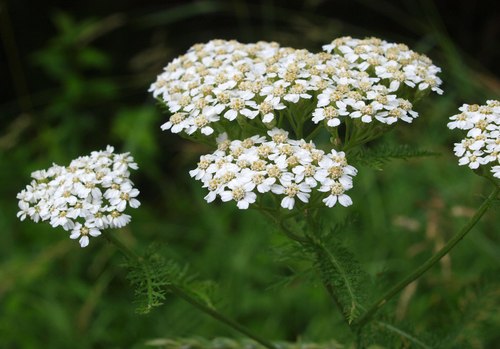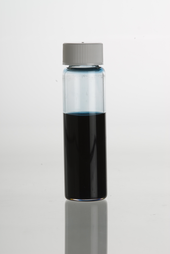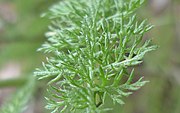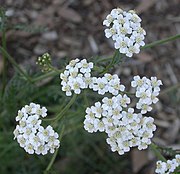Common Yarrow
Search
Wikipedia
| Achillea millefolium | |
|---|---|
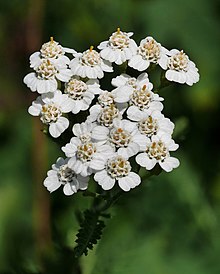
| |
|
Scientific classification | |
| Kingdom: | Plantae |
| Clade: | Tracheophytes |
| Clade: | Angiosperms |
| Clade: | Eudicots |
| Clade: | Asterids |
| Order: | Asterales |
| Family: | Asteraceae |
| Genus: | Achillea |
| Species: |
A. millefolium
|
| Binomial name | |
|
Achillea millefolium | |
| Synonyms | |
|
Synonymy
| |
Achillea millefolium, commonly known as yarrow (/ˈjæroʊ/) or common yarrow, is a flowering plant in the family Asteraceae. It is native to temperate regions of the Northern Hemisphere in Asia, Europe, and North America.[2] It has been introduced as a feed for livestock in New Zealand[3] and Australia, where it is a common weed of both wet and dry areas, such as roadsides, meadows, fields and coastal places.[3]
In New Mexico and southern Colorado, it is called plumajillo (Spanish for 'little feather') from its leaf shape and texture. In antiquity, yarrow was known as herba militaris, for its use in stanching the flow of blood from wounds.[4] Other common names for this species include gordaldo, nosebleed plant, old man's pepper, devil's nettle, sanguinary, milfoil, soldier's woundwort, thousand-leaf, and thousand-seal.[5]
Description

Achillea millefolium is an erect, herbaceous, perennial plant that produces one to several stems 0.2–1 m (8–40 in) in height, and has a spreading rhizomatous growth form. Leaves are evenly distributed along the stem, with the leaves near the middle and bottom of the stem being the largest. The leaves have varying degrees of hairiness (pubescence). The leaves are 5–20 cm (2–8 in) long, bipinnate or tripinnate, almost feathery, and arranged spirally on the stems. The leaves are cauline, and more or less clasping.[5]
The inflorescence has 4 to 9 phyllaries and contains ray and disk flowers which are white to pink. The generally 3 to 8 ray flowers are ovate to round. Disk flowers range from 15 to 40. The inflorescence is produced in a flat-topped capitulum cluster and the inflorescences are visited by many insects, featuring a generalized pollination system.[6] The small achene-like fruits are called cypsela.[5]
The plant has a strong, sweet scent, similar to that of chrysanthemums.[2]
Taxonomy
The several varieties and subspecies include:
-
Achillea millefolium subsp. millefolium
- A. m. subsp. m. var. millefolium – Europe, Asia
- A. m. subsp. m. var. borealis – Arctic regions
- A. m. subsp. m. var. rubra – Southern Appalachians
- A. millefolium subsp. chitralensis – western Himalaya
- A. millefolium subsp. sudetica – Alps, Carpathians
- Achillea millefolium var. alpicola – Western United States, Alaska[7]
- Achillea millefolium var. californica – California, Pacific Northwest[8][9][10]
- Achillea millefolium var. occidentalis – North America[11]
- Achillea millefolium var. pacifica – west coast of North America, Alaska[12]
- Achillea millefolium var. puberula – endemic to California[13]
Distribution and habitat
Yarrow grows from sea level to 3,500 m (11,500 ft) in elevation. The plant commonly flowers from May to July. Common yarrow is frequently found in the mildly disturbed soil of grasslands and open forests. Active growth occurs in the spring.[2][5]
The plant is native to Eurasia and is found widely from the UK to China.
In North America, both native and introduced genotypes, and both diploid and polyploid plants are found.[14] It is found in every habitat throughout California except the Colorado and Mojave Deserts.[15][16] Common yarrow produces an average yield of 110,000 plants per hectare (43,000/acre), with a total dry weight of 11,800 kg/ha (10,500 lb/acre).[17]
The plant is found in Australia as an introduction.
Ecology
Birds
Several cavity-nesting birds, including the common starling, use yarrow to line their nests. Experiments conducted on the tree swallow, which does not use yarrow, suggest that adding yarrow to nests inhibits the growth of parasites.[18]
Insects
Achillea millefolium is a food source for many species of insects.
- Moths
The larvae of the moths Bucculatrix clavenae, B. cristatella, B. fatigatella, B. humiliella, B. latviaella, Cnephasia abrasana, Cochylimorpha elongana, Coleophora argentula, C. carelica, C. ditella, C. expressella, C. follicularis, C. gardesanella, C. millefolii, C. partitella, C. ptarmicia, C. quadristraminella, C. succursella, C. vibicigerella, Depressaria olerella, D. silesiaca, Dichrorampha alpinana (broad-blotch drill), D. petiverella, D. vancouverana (tanacetum root moth), Eupithecia millefoliata (yarrow pug), E. nanata (narrow-winged pug), Gillmeria pallidactyla, Idaea pallidata, Isidiella nickerlii, Loxostege manualis, Phycitodes maritima, P. saxicola, Pyncostola bohemiella, Sophronia sicariellus and Thetidia smaragdaria (Essex emerald) feed on Achillea millefolium in Europe.
The larvae of Chlorochlamys chloroleucaria (blackberry looper), Coleophora quadruplex and Sparganothoides lentiginosana (lentiginos moth) feed on A. millefolium in North America.
Other species of moths with a more cosmopolitan distribution include Aethes smeathmanniana (Smeathmann's aethes moth), Chloroclystis v-ata (v-pug), Choristoneura diversana, Cochylidia richteriana, Epiblema graphana, Eupithecia succenturiata (bordered pug), E. vulgata (common pug), Jordanita budensis and Thiodia citrana (lemon bell).
- Beetles
Cassida denticollis, Galeruca tanaceti, Hypocassida subferruginea and Phytoecia virgula are cosmopolitan species of beetles that feed on A. millefolium.
Chrysanthia viridissima is a European species whose adults can be found feeding on pollen and nectar.
Trichodes ornatus (ornate checkered beetle) is a species found in North America whose adults can be found feeding on A. millefolium.
- True bugs
Horistus orientalis is a species of plant bugs that feeds on A. millefolium.
- Wasps
Hedychrum rutilans is a species of cuckoo wasps whose adults can be found feeding on A. millefolium in Europe and North Africa.
Cultivation

Achillea millefolium is cultivated as an ornamental plant by many plant nurseries. It is planted in gardens and natural landscaping settings of diverse climates and styles. They include native plant, drought-tolerant, and wildlife gardens. The plant is a frequent component of butterfly gardens. The plant prefers well-drained soil in full sun, but can be grown in less ideal conditions.[19][20][21]
Propagation
For propagation, seeds require light for germination, so optimal germination occurs when planted no deeper than 6 mm (1⁄4 in). Seeds also require a germination temperature of 18–24 °C (64–75 °F). It has a relatively short life in some situations, but may be prolonged by division in the spring every other year, and planting 30 to 46 cm (12–18 in) apart. It can become invasive.[22]
Cultivars
The species use in traditional gardens has generally been superseded by cultivars with specific 'improved' qualities.[23] Some are used as drought tolerant lawn replacements, with periodic mowing.[24] The many different ornamental cultivars include: 'Paprika',[25] 'Cerise Queen', 'Red Beauty',[26] 'Red Velvet',[27] 'Saucy Seduction', 'Strawberry Seduction' (red), 'Island Pink' (pink),[28] and 'Calistoga' (white),[29] and 'Sonoma Coast' (white).[30] The following are recipients of the Royal Horticultural Society's Award of Garden Merit:
The many hybrids of this species designated Achillea × taygetea are useful garden subjects,[35] including: 'Appleblossom', 'Fanal', 'Hoffnung', and 'Moonshine'.[36]
Folklore
The English name yarrow comes from its Saxon (Old English) name gearwe, which is related to both the Dutch word gerw (alternately yerw[37]) and the Old High German word garawa.[38] In the eastern counties it may be called yarroway.[37]
The genus name Achillea is derived from mythical Greek character, Achilles, who reportedly carried it with his army to treat battle wounds.[39] The specific name millefolium as well as the common names milfoil and thousand weed come from the featherlike leaves which appear to be divided into a thousand.[39]
For its historical use in wound healing particularly in the military it was called bloodwort, herba militaris, knight's milfoil, staunchweed, and, from its use in the US Civil War, soldier's woundwort.[39] Its use in either starting or stopping nosebleeds led to the common name nosebleed.[37][40] For its association with the Abrahamic Devil it was called bad man's plaything, devil's nettle, and devil's plaything.[37] It was called old man's pepper due to its pungent flavor, while the name field hop came from its use in beer making in Sweden.[37]
Other traditional names for A. millefolium include arrowroot, carpenter's weed,[37] death flower, eerie, hundred leaved grass, knyghten, old man's mustard, sanguinary,[37] seven-year's love, snake's grass, soldier, and thousand seal.
Greece
In classical Greece, Homer tells of the centaur Chiron, who conveyed herbal secrets to his human pupils, and taught Achilles to use yarrow on the battle grounds of Troy.[41]
China
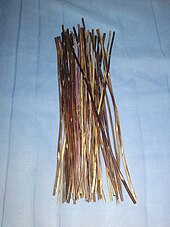
Yarrow and tortoiseshell are considered to be lucky in Chinese tradition.[42]
The stalks are dried and used as a randomising agent in I Ching divination.[43]
British Isles
In the Hebrides a leaf held against the eyes was sometimes believed to give second sight.[44]
In Sussex and Devonshire superstition, yarrow was used for finding one's real sweetheart. One would pluck yarrow growing on a young man's grave while reciting:
- Yarrow, sweet yarrow, the first that I have found,
in the name of Jesus Christ, I pluck it from the ground;
As Joseph loved sweet Mary, and took her for his dear,
so in a dream this night, I hope, my true love will appear.
and go to sleep with the yarrow under the pillow.[40]
In a similar tradition in Wicklow, girls would pick yarrow on Hallow Eve and recite:
- Thou pretty herb of Venus' tree,
Thy true name is yarrow;
Now who my bosom friend may be,
Pray tell thou me to-morrow.
then retire for the night without speaking and go to sleep with an ounce of yarrow sewn in flannel under the pillow.[40]
In Suffolk a leaf was placed in the nose so it would bleed, while reciting
-
Green 'arrow, green 'arrow, you bears a white blow,
If my love love me, my nose will bleed now;
If my love don't love me, it 'on't bleed a drop,
If my love do love me, 'twill bleed every drop.[40]
In Dublin on May Day or the night before, women would place a stocking full of yarrow under their pillow and recite:
-
Good morrow, good yarrow, good morrow to thee,
I hope by the yarrow my lover to see;
And that he may be married to me.
The colour of his hair and the clothes he does wear,
And if he be for me may his face be turned to me,
And if he be not, dark and surely may he be,
And his back be turned toward me.[40]
In the witchcraft trial of Elspeth Reoch in March 1616, she was alleged to have plucked "melefour," thought to be another name for yarrow, and said "In nomine Patris, Fiili, et Spiritus Sancti" to become able to cure distemper (disorders of the four humours) and impart the faculty of prediction.[40]
Yarrow was thought to bring luck due to being "the first herb our Saviour put in His had when a child."[40]
Uses
Some pick-up sticks are made of yarrow.
Yarrow can be used for dying wool as it contains apigenin and luteolin. Depending on the mordant the color may be green to yellow.[45]
Companion planting
Yarrow is considered an especially useful companion plant, attracting beneficial insects and repelling some pests. It attracts predatory wasps, which drink the nectar and then use insect pests as food for their larvae. Similarly, it attracts ladybirds and hoverflies.[21]
Agriculture
A. millefolium can be planted to combat soil erosion due to the plant's resistance to drought. Before the arrival of monocultures of ryegrass, both grass and pasture contained A. millefolium at a density of about 0.3 kg/ha.[citation needed] One factor for its use in grass mixtures was its deep roots, with leaves rich in minerals, minimizing mineral deficiencies in ruminant feed. It was introduced into New Zealand as a drought-tolerant pasture.[3]
Food
Yarrow leaves have a delicate grassy flavour, with a slight aniseed taste. This makes them useful for brewing as a tea.[46] They are abundant in grassland and so can easily be foraged; the leaves are useful in salad, chopped in cooking as a herb, and steeped in hot water for a tea.
In the Middle Ages, yarrow was part of a herbal mixture known as gruit used in the flavoring of beer prior to the use of hops.[47] The flowers and leaves are used in making some liquors and bitters.[2]
When consumed by cows, an unfavorable flavor is given to their milk.[48]
Traditional medicine
A. millefolium was used as in traditional medicine, possibly due to its astringent effects.[2] Yarrow and its North American varieties were traditionally used by many Native American nations.[49] The Navajo historically considered it a "life medicine" and chewed the plant for toothaches and used its infusions for earaches. The Miwok in California used the plant as an analgesic and head cold remedy.[49] Native American nations used the plant for healing cuts and abrasions, for relief of ear-aches, and throat infections, and for an eye-wash.[50] Common yarrow was used by Plains indigenous peoples to reduce pain or fever and aid sleep.[49]
In the early 20th century, some Ojibwe people used a decoction of yarrow leaves on hot stones and inhaled it to treat headaches,[51] or applied decoctions of the root onto skin for its stimulating effect.[52]
Dangers
In rare cases, yarrow can cause severe allergic skin rashes; prolonged use can increase the skin's photosensitivity.[53] This can be triggered initially when wet skin comes into contact with cut grass and yarrow together.
According to the ASPCA, yarrow is toxic to dogs, cats, and horses, causing increased urination, vomiting, diarrhea and dermatitis.[54]
In a standard rodent model for reproductive toxicity, aqueous extracts of yarrow produced a significant increase in the percentage of abnormal sperm.[55]
Chemistry
The dark blue essential oil of yarrow contains chemicals called proazulenes.[56]
Chamazulene and δ-Cadinol are chemical compounds found in A. millefolium. The chromophore of azulene was discovered in yarrow and wormwood and named in 1863 by Septimus Piesse.
Yarrow contains isovaleric acid, salicylic acid, asparagine, sterols, and flavonoids.[57]
Gallery
Illustration in Koehlers Medizinal-Pflanzen in naturgetreuen Abbildungen und kurz erläuterndem Texte (Franz Eugen Köhler; 1883–1914).
Achillea millefolium at BioTrek, California State Polytechnic University, Pomona.
References
- ^ Maiz-Tome, L. (2016). "Achillea millefolium". IUCN Red List of Threatened Species. 2016: e.T202909A78457012. doi:10.2305/IUCN.UK.2016-1.RLTS.T202909A78457012.en. Retrieved 12 November 2021.
- ^ a b c d e "Missouri Botanical Gardens".
- ^ a b c "RNZIH – Horticulture Pages – Weeds – Achillea millefolium – yarrow". www.rnzih.org.nz. Retrieved 2 September 2015.
- ^ Dodson & Dunmire, 2007, Mountain Wildflowers of the Southern Rockies, UNM Press, ISBN 978-0-8263-4244-7
- ^ a b c d Flora of North America Editorial Committee (ed.). "Achillea millefolium". Flora of North America North of Mexico (FNA). New York and Oxford. Retrieved 31 January 2013 – via eFloras.org, Missouri Botanical Garden, St. Louis, MO & Harvard University Herbaria, Cambridge, MA.
- ^ Van Der Kooi, C. J.; Pen, I.; Staal, M.; Stavenga, D. G.; Elzenga, J. T. M. (2015). "Competition for pollinators and intra-communal spectral dissimilarity of flowers". Plant Biology. 18 (1): 56–62. doi:10.1111/plb.12328. PMID 25754608.
- ^ USDA Plants Profile for Achillea millefolium var. alpicola (common yarrow) . accessed 31 January 2013
- ^ Profile for Achillea millefolium var. californica (California yarrow) . accessed 31 January 2013
- ^ Tropicos: Achillea millefolium var. californica . accessed 31 January 2013
- ^ Bert Wilson (29 July 2012). "Las Pilitas Nursery horticultural treatment: Achillea millefolium var. californica". Laspilitas.com. Retrieved 19 May 2013.
- ^ USDA Plants Profile for Achillea millefolium var. occidentalis (western yarrow). Accessed 31 January 2013.
- ^ USDA Plants Profile for Achillea millefolium var. pacifica (Pacific yarrow) . accessed 31 January 2013
- ^ USDA Plants Profile for Achillea millefolium var. puberula . Accessed 31 January 2013.
- ^ Alan S. Weakley (April 2008). "Flora of the Carolinas, Virginia, and Georgia, and Surrounding Areas".
- ^ Jepson Manual treatment for ACHILLEA millefolium . accessed 31 January 2013
- ^ Calflora database: Achillea millefolium . Accessed 31 January 2013.
- ^ "A Grower's Guide_Yarrow_Achillea millefolium" (PDF). Archived from the original (PDF) on 7 October 2013. Retrieved 27 August 2013.
- ^ Shutler D, Campbell AA (2007). "Experimental addition of greenery reduces flea loads in nests of a non-greenery using species, the tree swallow Tachycineta bicolor". Journal of Avian Biology. 38 (1): 7–12. doi:10.1111/j.2007.0908-8857.04015.x.
- ^ "Missouri Botanical Garden horticultural treatment: Achillea millefolium". Retrieved 31 January 2013.
- ^ "Fine Gardening magazine Plant Guide – Achillea millefolium (Yarrow)". Retrieved 31 January 2013.
- ^ a b "Lady Bird Johnson Wildflower Center Native Plant Database: Achillea millefolium (common yarrow)". Retrieved 31 January 2013.
- ^ USDA, NRCS. 2006. The PLANTS Database (http://plants.usda.gov, 22 May 2006). National Plant Data Center, Baton Rouge, LA 70874-4490 USA.[1]
- ^ RHS A-Z encyclopedia of garden plants. United Kingdom: Dorling Kindersley. 2008. p. 1136. ISBN 978-1-4053-3296-5.
- ^ San Marcos Growers horticulture – The Yarrow Lawn. Accessed 31 January 2013.
- ^ "Missouri Botanical Garden horticultural treatment: Achillea millefolium 'Paprika'". Missouribotanicalgarden.org. Retrieved 19 May 2013.
- ^ "Missouri Botanical Garden horticultural treatment: Achillea millefolium 'Red Beauty'". Missouribotanicalgarden.org. Retrieved 19 May 2013.
- ^ RHS: Achillea millefolium 'Red Velvet'
- ^ Bert Wilson (8 January 2012). "Las Pilitas Nursery: Achillea millefolium rosea Island Pink (Pink Yarrow)". Laspilitas.com. Retrieved 19 May 2013.
- ^ "California Natives Wiki: Achillea millefolium 'Calistoga'". Theodorepayne.org. 19 August 2010. Archived from the original on 21 March 2015. Retrieved 19 May 2013.
- ^ "California Natives Wiki: Achillea millefolium 'Sonoma Coast'". Theodorepayne.org. 19 August 2010. Archived from the original on 21 March 2015. Retrieved 19 May 2013.
- ^ "Achillea 'Credo'". RHS. Retrieved 27 February 2020.
- ^ "Achillea 'Lachsschönheit' (Galaxy Series)". RHS. Retrieved 27 February 2020.
- ^ "Achillea 'Martina'". RHS. Retrieved 27 February 2020.
- ^ "Achillea millefolium 'Lansdorferglut'". RHS. Retrieved 27 February 2020.
- ^ Clausen, Ruth Rogers; Ekstrom, Nicolas H. (1989). Perennials for American gardens. New York: Random House. p. 4. ISBN 978-0-394-55740-3.
- ^ Monrovia Growers: Achillea x 'Moonshine' – Moonshine Yarrow.
- ^ a b c d e f g Margaurt Grieve (1931). A Modern Herbal.
- ^ Yarrow. Oxford English Dictionary (2nd ed.).
- ^ a b c Chandler; Hooper; Harvey (1982). "Ethnobotany and phytochemistry of yarrow, Achillea millefolium, compositae". Economic Botany. 36 (2): 203–223. doi:10.1007/BF02858720. S2CID 27867476.
- ^ a b c d e f g Britten, James (1878). Folk-Lore Record. 1. Folklore Enterprises, Ltd., Taylor & Francis. pp. 32, 156–157. doi:10.1080/17441994.1878.10602548. JSTOR 1252356.
- ^ Homer. Iliad. pp. 11.828–832.
- ^ "Chinese Superstitions". Chinatownconnection.com. Retrieved 19 May 2013.
- ^ "Introduction to the I Ching – By Richard Wilhelm". Iging.com. Retrieved 19 May 2013.
- ^ Margaret Baker (October 1971). Discovering the Folklore of Plants (revised ed.). Shire Publications. SBN 852630806.
- ^ Kiumarsi; Abomahboub; Rashedi; Parvinzadeh (2009). "Achillea Millefolium, a New Source of Natural Dye for Wool Dyeing". Progress in Color, Colorants and Coatings. 2 (2): 87–93.
- ^ Benoliel, Doug (2011). Northwest Foraging: The Classic Guide to Edible Plants of the Pacific Northwest (Rev. and updated ed.). Seattle, WA: Skipstone. p. 179. ISBN 978-1-59485-366-1. OCLC 668195076.
- ^ Lanneskog, Thor (5 October 2015). "This Is Genuine Viking Beer". ThorNews. Retrieved 5 October 2015.
- ^ Reiner, Ralph E. (1969). Introducing the Flowering Beauty of Glacier National Park and the Majestic High Rockies. Glacier Park, Inc. p. 16.
- ^ a b c University of Michigan – Dearborn: Native American Ethnobotany; Achillea millefolium . accessed 31 January 2013
- ^ Faran, Mina; Tcherni, Anna (1997). Medicinal herbs in Modern Medicine (ṣimḥei marpé bir'fū'ah ha-modernīt) (in Hebrew). 1. Jerusalem: Akademon (Hebrew University of Jerusalem). p. 242. ISBN 965-350-068-6. OCLC 233179155., s.v. Achillea millefolium
- ^ Densmore, Frances, 1928, Uses of Plants by the Chippewa Indians, SI-BAE Annual Report #44:273–379, page 336
- ^ Densmore, Frances, 1928, Uses of Plants by the Chippewa Indians, SI-BAE Annual Report #44:273–379, page 350
- ^ Contact Dermatitis 1998, 39:271–272.
- ^ "Toxic and Non-Toxic Plants: Yarrow". ASPCA.
- ^ Dalsenter P, Cavalcanti A, Andrade A, Araújo S, Marques M (2004). "Reproductive evaluation of aqueous crude extract of Achillea millefolium L. (Asteraceae) in Wistar rats". Reprod Toxicol. 18 (6): 819–23. doi:10.1016/j.reprotox.2004.04.011. PMID 15279880.
- ^ Michler, Barbara; Arnold, Carl-Gerold (1999). "Predicting Presence of Proazulenes in the Achillea millefolium Group". Folia Geobotanica. 34 (1): 143–161. doi:10.1007/BF02803081. JSTOR 4201352. S2CID 12541991.
- ^ Home Herbal: Cook, Brew & Blend Your Own Herbs. DK Pub. 2011. ISBN 978-0-7566-7183-9.
External links
| Wikimedia Commons has media related to Achillea millefolium. |
| Wikiversity has bloom time data for Achillea millefolium on the Bloom Clock |
- Kansas Wildflowers – Achillea millefolium
- Dr. Duke's Databases: Achillea millefolium
- Winter identification photographs
- Achillea millefolium L. Medicinal Plant Images Database (School of Chinese Medicine, Hong Kong Baptist University) (in Chinese) (in English)
- IUCN Red List least concern species
- Achillea
- Butterfly food plants
- Drought-tolerant plants
- Flora of North America
- Flora of Europe
- Flora of Asia
- Garden plants of Europe
- Garden plants of North America
- Groundcovers
- Herbs
- Medicinal plants of Asia
- Medicinal plants of Europe
- Plants described in 1753
- Plants used in traditional Native American medicine
- Taxa named by Carl Linnaeus
- Flora of California
